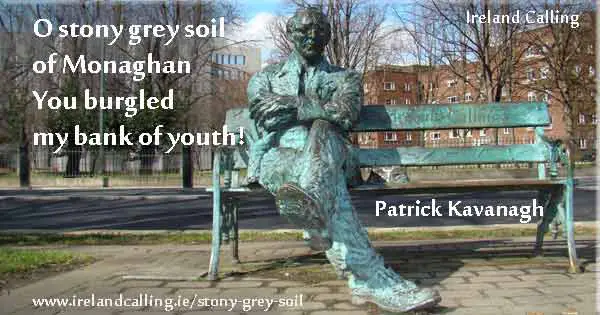Patrick Kavanagh is one of Ireland’s most remarkable writers. He left school at 13 and had no formal education, yet went on to become one of the country’s literary giants.
Kavanagh’s walk to Dublin
More great Irish writers
His work is now studied in schools and universities that he couldn’t afford to attend, and the literary establishment that once scoffed at his country ways now regard him one of the major poets of the 20th century.

He had a huge influence on a generation of Irish poets including the Nobel Prize winner Seamus Heaney.
Kavanagh’s major works include The Great Hunger, The Green Fool and Tarry Flynn.
All great civilisations are based on the parish.
Patrick Kavanagh
In the early 1940s, he fell madly in love with a beautiful young student in Dublin. She rejected his advances but wished to remain friends with him.
She encouraged him to write a love poem. He responded with what is now perhaps his most famous work, Raglan Road. It was later turned into a popular song performed by numerous major artists such as The Dubliners and Van Morrison.
A man innocently dabbles in words and rhymes and finds that it is his life.
Patrick Kavanagh
Most of Kavanagh’s work centres of the lives of ordinary Irish farm workers, which earned him the title of the Peasant Poet – a description he hated. His great gift was to be able to take the everyday experiences of ordinary people and describe them in such a way that they had universal appeal to people from all walks of life.
Kavanagh was born on 21 October 1904 at Inniskeen in Co Monaghan in the north of Ireland. His father was a farmer and shoe maker. Kavanagh left school at the age of 13 and began learning the shoe making trade.
He gave up about a year later saying that despite his efforts, he had not managed to make one pair of wearable shoes.
Peasant life lacked learning and artistic fulfilment
He began writing poems while working on the family farm. He was also quite athletic and played as goalkeeper for the Iniskeen Gaelic Football team.
This was during the 1920s, a period of extreme poverty in Ireland. Kavanagh felt this poverty deeply, although he considered that an even greater problem for rural people was the lack of education, knowledge and artistic and spiritual fulfilment.
He said: “The real poverty was lack of enlightenment … I am afraid this fog of unknowing affected me dreadfully.”
Kavanagh was desperate to escape the oppressive drudgery of the peasant lifestyle and saw writing as a way out. He had his first big breakthrough in 1928 when he had a few poems published in the Dundalk Democrat and Irish Independent newspapers.
This encouraged him to submit some of his work to the writer and philosopher George Russell, who wrote under the name of A E Russell.
Russell was a well established figure in the Irish Literary Revival. Although he rejected Kavanagh’s early work, he encouraged him to keep trying and eventually began to feature some of his poems in his publication, the Irish Statesman.
Kavanagh’s 50 mile walk to Dublin and literary fame
Raglan Road videos – a love affair doomed to fail
More popular articles and videos
The real life mystery of what Maureen O’Hara whispered to make John Wayne look so shocked
Matt Damon winning hearts and minds with charm assault on Ireland
Action hero Tom Cruise was once attacked by an old man in a Kerry pub
Liam Neeson speaks about his late wife in emotional interview
Dating site explains why Irish men make wonderful husband material
Billy Connolly says public should ignore politicians and listen to comedians
Take a look inside Hollywood star Saoirse Ronan’s stunning Irish home
